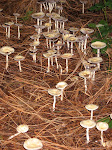 Looking like a flock of white doves, the dogwood blossoms now bower over the soon-to-be shaded earth.
Looking like a flock of white doves, the dogwood blossoms now bower over the soon-to-be shaded earth.We’re blessed with extensive groves of Mountain Dogwoods (Cornus nuttallii) that form a lower canopy under the evergreens each summer. The trees range in size from small 3-4 foot high shrub-like bushes to 40-50 foot high "ancient" trees. An ancient tree is usually 40+ years old. The older trees are uncommon since they are susceptible to anthracnose, battle established trees for light and suffer limb-breaking snows in the winters.
While the trees favor moist areas, we find that the trees with the most blossoms are those that receive a healthy dose of sunshine. Sometimes you’ll see a large tree with only a single side branch with flowers. More than likely, that branch probably receives the only sunlight while the rest of the tree remains shaded by taller trees throughout the day.
The trees provide year-long interest - When summer draws to a close, the seemingly dead flower heads swell into bright red clusters of berries. The Stellar Jays and Flickers go wild over them. After gorging on the fruits, the birds spread the seeds through their droppings. In the autumn, the leaves turn beautiful shades of red, yellow, pink and bronze, proving that the West Coast has fall color too.
(Photo: Dogwood blossoms)









